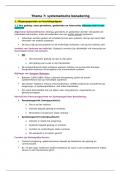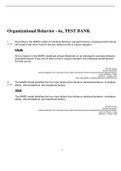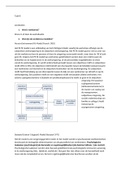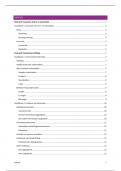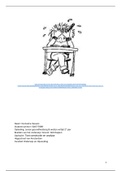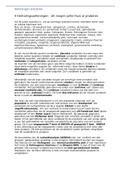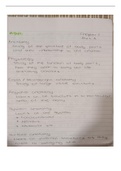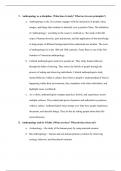INSTRUMENTS
Pressure
• Aneroid capsule/pressure diaphragm used for
- Low pressure fuel pump
- Intake pressure of gas turbine engine powerplant
- Manifold pressure gauge
• Bellows sensor used for
- Cabin differential pressure
- Fuel pressure gauge
- Manifold pressure
• Bourdon tube/transducer measures hydraulic pressure
• Manifold pressure is absolute pressure in intake near inlet valve
• 1 BAR = 15 psi = 1000hpa or 100000 PASCAL
Temperature
• SAT = TAT – (Ram rise x Kr)
SAT = RAT ÷ [1+ (0.2 x Kr x M2)]
SAT = TAT ÷ [1+ (0.2 x M2)]
• Ratiometer: Operates without SUPPLY VOLTAGE*
• Bimetallic thermometers
- Based on iron & brass having different coefficients of linear expansion
- - 50°c to 400°C
• Thermocouple
- Temperature increase voltage increase
- Uses thermoelectric effect to measure differential temperature
Fuel measurement
• Electric float: Simple, independence of power supply voltage if made of ratiometer
• Integrating fuel flow with respect to time
• Mechanical fuel flow meter: Spring loaded vane
Tachometer
• Measures angular speed
• Transmitter fitted with magnetic sensor connected to an RPM indicator: Permanent magnet rotating in a non-
magnetic cup, AC converted to square pulses
• Magnetic tachometer: Permanent magnet rotating inside a non-magnetic cup
• Mechanical: Shaft rotates magnet in drag cup
• Electronic: Inductive probe/notched wheel rotating in a magnetic field. Uses magnetic sensor, Disadvantage:
Needs power supply
• Electrical: Uses generator, magnet rotor, principle of measuring rotation speed of a synchronous motor
energized by an alternator
1. DC generator:
- Advantage: Easy transmission, independent of power supply
- Disadvantage: Spurious signals
2. Single phase:
- Advantage: Suppression of spurious signals due to D.C, independent of power supply, simple design, no
influence of temperature
- Disadvantage: Suffers line resistance, transmission problems
3. 3 Phase: Consists of generator, synchronous motor turning drag cup & magnetic tachometer. Frequency
varies with RPM. (Most common)
4. Electrical induction:
- Advantage: Not sensitive to line resistance, independent of power supply, can use several indicators
connected in parallel to a single transmitter
- Disadvantage: Affected by temperature variations
, - Rotation speed of an asynchronous motor energized by alternator
FADEC
• Flow regulation, auto start, engine data transmission to cockpit, management/protection of engine limits, thrust
reverser operations, auto thrust but no auto shutdown, no airspeed or yaw modification
• Flexible take-off: Where full power not required, increasing engine life. By selecting higher ambient air temp for
reduced power. Conditions: Low take-off mass, low OAT, high atmospheric pressure
• EPR inlet blocked, indications over reads, EPR = Quotient of pressure at exhaust & compressor inlet
Turbine exhaust ÷ compressor inlet
• Engine speed displayed with % value of max RPM e.g. N1(% RPM value of LP spool), N2(Second spool)
• N1 can be greater than 100%
Torque meter (16119,25057)
• Torque (Nm) measured by:
1. Measuring change in phase between torque & reference shaft
2. Total twist of engine output shaft over a known distance
3. Oil pressure at the fixed crown of a reducer of the main engine gearbox
• Electronic torque meter: Increase in power causes twisting of the torque shaft
• Oil/Hydraulic torque meter uses helical cut gears & torque proportional to axial load
• Torque = Power ÷ RPM
Torque = Force x Distance/lever arm
Power = Work done ÷ time
Power = Torque x Angular velocity
Synchroscope
• Measures difference in output frequencies of both alternators connected to gear box
• Master engine is outer left engine
• Uses piezo-electric crystals or magnets, 2 accelerometers
• Magnetic chip detectors: Warn of impending failure
• Reduces structural vibration & noise, set several engines to the same speed, does not synchronize but does
reduce fuel consumption
Altimeter
• Pressure in cabin less than outside due to aerodynamic suction static pressure is less, so altimeter thinks that
you are higher so it over-reads
• Blocked static port, capsule senses lower pressure, thus ASI & altimeter over reads at high speed/sideslip
• HYSTERISIS(lag) error: varies with time passed at given altitude
• Electromagnetic pick-off makes the altimeter more accurate, vibration motor reduces friction
• Density altitude: Altitude of standard atmosphere on which density is equal to the actual density of the
atmosphere
• QNH = Equivalent sea level pressure at the airfield
VSI
• Accuracy between +50°C & -20°C : +/- 200ft
• Uses correction based on an accelerometer sensor, acceleration pump
• Pressure inside capsule drops faster than inside the case
Airspeeds/ASI
• ECTM
• Mach no: TAS/LSS
• LSS: 38.95 x √OAT (In kelvin)
• During pitot LEAK (NOT blocked) sensed dynamic pressure reduces, ASI UNDEREADS
• Inside capsule is total pressure & inside case is static pressure
• During take-off if question mentions altitude, answer is CAS speed constant, if not EAS
• Compressibility taken into account for aircraft moving more than 200 knots
• TAS = IAS + 10%
• IAS: Remains unchanged in head/tail wind
Pressure
• Aneroid capsule/pressure diaphragm used for
- Low pressure fuel pump
- Intake pressure of gas turbine engine powerplant
- Manifold pressure gauge
• Bellows sensor used for
- Cabin differential pressure
- Fuel pressure gauge
- Manifold pressure
• Bourdon tube/transducer measures hydraulic pressure
• Manifold pressure is absolute pressure in intake near inlet valve
• 1 BAR = 15 psi = 1000hpa or 100000 PASCAL
Temperature
• SAT = TAT – (Ram rise x Kr)
SAT = RAT ÷ [1+ (0.2 x Kr x M2)]
SAT = TAT ÷ [1+ (0.2 x M2)]
• Ratiometer: Operates without SUPPLY VOLTAGE*
• Bimetallic thermometers
- Based on iron & brass having different coefficients of linear expansion
- - 50°c to 400°C
• Thermocouple
- Temperature increase voltage increase
- Uses thermoelectric effect to measure differential temperature
Fuel measurement
• Electric float: Simple, independence of power supply voltage if made of ratiometer
• Integrating fuel flow with respect to time
• Mechanical fuel flow meter: Spring loaded vane
Tachometer
• Measures angular speed
• Transmitter fitted with magnetic sensor connected to an RPM indicator: Permanent magnet rotating in a non-
magnetic cup, AC converted to square pulses
• Magnetic tachometer: Permanent magnet rotating inside a non-magnetic cup
• Mechanical: Shaft rotates magnet in drag cup
• Electronic: Inductive probe/notched wheel rotating in a magnetic field. Uses magnetic sensor, Disadvantage:
Needs power supply
• Electrical: Uses generator, magnet rotor, principle of measuring rotation speed of a synchronous motor
energized by an alternator
1. DC generator:
- Advantage: Easy transmission, independent of power supply
- Disadvantage: Spurious signals
2. Single phase:
- Advantage: Suppression of spurious signals due to D.C, independent of power supply, simple design, no
influence of temperature
- Disadvantage: Suffers line resistance, transmission problems
3. 3 Phase: Consists of generator, synchronous motor turning drag cup & magnetic tachometer. Frequency
varies with RPM. (Most common)
4. Electrical induction:
- Advantage: Not sensitive to line resistance, independent of power supply, can use several indicators
connected in parallel to a single transmitter
- Disadvantage: Affected by temperature variations
, - Rotation speed of an asynchronous motor energized by alternator
FADEC
• Flow regulation, auto start, engine data transmission to cockpit, management/protection of engine limits, thrust
reverser operations, auto thrust but no auto shutdown, no airspeed or yaw modification
• Flexible take-off: Where full power not required, increasing engine life. By selecting higher ambient air temp for
reduced power. Conditions: Low take-off mass, low OAT, high atmospheric pressure
• EPR inlet blocked, indications over reads, EPR = Quotient of pressure at exhaust & compressor inlet
Turbine exhaust ÷ compressor inlet
• Engine speed displayed with % value of max RPM e.g. N1(% RPM value of LP spool), N2(Second spool)
• N1 can be greater than 100%
Torque meter (16119,25057)
• Torque (Nm) measured by:
1. Measuring change in phase between torque & reference shaft
2. Total twist of engine output shaft over a known distance
3. Oil pressure at the fixed crown of a reducer of the main engine gearbox
• Electronic torque meter: Increase in power causes twisting of the torque shaft
• Oil/Hydraulic torque meter uses helical cut gears & torque proportional to axial load
• Torque = Power ÷ RPM
Torque = Force x Distance/lever arm
Power = Work done ÷ time
Power = Torque x Angular velocity
Synchroscope
• Measures difference in output frequencies of both alternators connected to gear box
• Master engine is outer left engine
• Uses piezo-electric crystals or magnets, 2 accelerometers
• Magnetic chip detectors: Warn of impending failure
• Reduces structural vibration & noise, set several engines to the same speed, does not synchronize but does
reduce fuel consumption
Altimeter
• Pressure in cabin less than outside due to aerodynamic suction static pressure is less, so altimeter thinks that
you are higher so it over-reads
• Blocked static port, capsule senses lower pressure, thus ASI & altimeter over reads at high speed/sideslip
• HYSTERISIS(lag) error: varies with time passed at given altitude
• Electromagnetic pick-off makes the altimeter more accurate, vibration motor reduces friction
• Density altitude: Altitude of standard atmosphere on which density is equal to the actual density of the
atmosphere
• QNH = Equivalent sea level pressure at the airfield
VSI
• Accuracy between +50°C & -20°C : +/- 200ft
• Uses correction based on an accelerometer sensor, acceleration pump
• Pressure inside capsule drops faster than inside the case
Airspeeds/ASI
• ECTM
• Mach no: TAS/LSS
• LSS: 38.95 x √OAT (In kelvin)
• During pitot LEAK (NOT blocked) sensed dynamic pressure reduces, ASI UNDEREADS
• Inside capsule is total pressure & inside case is static pressure
• During take-off if question mentions altitude, answer is CAS speed constant, if not EAS
• Compressibility taken into account for aircraft moving more than 200 knots
• TAS = IAS + 10%
• IAS: Remains unchanged in head/tail wind

